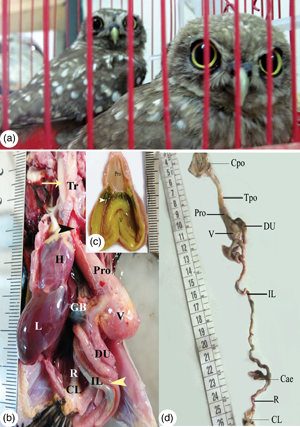Published online by Cambridge University Press: 25 March 2022

The digestive tract of the little owl, Athene noctua (Strigiformes: Strigidae), is described in two different seasons. The digestive tract of this bird follows the basic model for that of a predatory bird. The cervical esophagus is not expanded to form a crop. The internal surface of the esophagus forms numerous longitudinal folds provided with numerous mucous glands. These longitudinal folds increase in number and vary in depth posteriorly. The folds of the proventriculus are composed of simple branched tubular glands. The ventriculus is lined by a thin layer of koilin. The number of goblet cells gradually increases from the duodenum to the rectum, and the lymphatic tissue diffuses within the lamina propria. The esophageal glands secrete acid mucopolysaccharides, while the gastric glands of the stomach, the goblet cells, and crypts of Lieberkühn secrete acid mucopolysaccharides. Proteins were observed in the different histological structures of the digestive tract. Morphometric and histometric studies showed differences between summer and winter in the esophagus and glandular stomach (especially in winter), but no seasonal differences were seen in the muscular stomach, or small and large intestines.